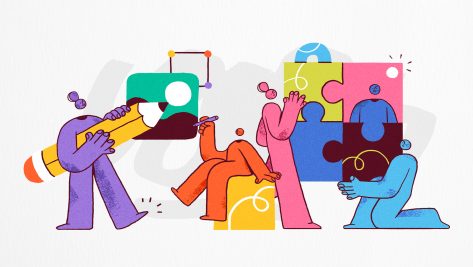We are living and working in a time in which it is necessary for HR to pull out all the stops. Essentially, this is a moment of reset in work and in the workplace that has been accelerated by serious changes in people’s attitudes about work itself. It plays on all levels, with themes such as leadership, inclusivity, flexibility, learning climate, mental health, vitality, data, and analytics. The changes we are facing have accelerated by 10 times compared to pre-Covid. Yet, at the same time, there are far too few people to fill specific jobs in many geographies, and that is not getting any better. The Great Resignation will continue to impact the future of work and HR must prepare for the long haul – in fact, many organizations must make changes in order to attract and retain talented people.
A culture that provides psychological safety, is human, engaging, is clear about its meaning and purpose, and supports personal learning and growth. But how can that be done? What exactly does HR need to do to achieve it?
Step 1: Start with the leaders
Human resources professionals are positioned between the organizational leaders and the employees – and both demand attention. Yet, culture is first and foremost about leadership, and better leaders make for a better culture. Of course, there is often a significant difference between what leaders say and what they do, not to mention how it is experienced by others. Frequently leaders are unaware of this.
It is therefore important for HR professionals to provide the leaders within their companies with insights about their leadership style by using a 360-degree feedback instrument. This way they can see, thanks to data, exactly how they are doing. They may think they pay attention to their people, inspire others, demonstrate exemplary behaviors, and give constructive feedback, but maybe the reality is that they micro-manage. It is the job of HR to look at how leaders are shaping the culture of the company and then help them adjust their actual leadership efforts to the desired cultural goals and outcomes.
To make such changes in company culture, it is essential to have a safe environment. Employees must feel that they can speak up and that their leaders will not only embrace that process but take the lead in creating an open dialogue. This is why HR must also focus on the leaders of the company, because everything starts and ends with them. They must truly listen and be open to feedback from their employees, and peers, and this willingness on their part must be apparent to everyone in the organization.
Step 2: Know your organization
A better corporate culture does not start with a directive from the board. To that point, generic HR policies won’t make a difference in helping a company become a magnet for talent. Rather, it’s about listening, recognizing the achievements of individuals and teams, giving real-time feedback, and providing opportunities for growth and development. The foundation of company culture is built on daily, focused attention.
The first step is having a good sense of the people who work for you. Who are they? What do they care about? What motivates them to high performance? What do they need from you? Furthermore, the various groups within a company, particularly in a large multinational, bring with them different perspectives. Those who work in a plant, or who do administrative work, or care for patients in healthcare, or are highly educated knowledge workers, all have varying experiences and perspectives. Older employees bring a unique perspective, as do the parents of young children, and recent graduates who have just finished their studies. It is important for HR to map out the needs of each and every segment of the workforce.
Forcing people to adapt to a specific culture or career is not possible anymore.
Inclusivity is paramount. This means looking at all the people who support the organization independent of their legal agreement with the company, including full-timers, part-timers, freelancers, and suppliers. At the end of the day, it is about keeping everyone connected to and engaged with the organization, because the culture is determined by the whole. HR’s challenge is to ensure that everyone feels valued by the organization.
Step 3: Talk to everyone
After mapping out the employee groups, it is time to find out what they need. This can be done in a variety of ways, such as surveys or one-on-one conversations. Broader research efforts also work, for example analyzing the labor market to better understand the temperature of the market and workforce.
As in all areas of life, it is best to put oneself in the shoes of others and this is what HR professionals should do with employees in order to understand the individual needs of workers. For example, there are many who will begin looking at other employment opportunities if they are required by their employer to return to the office again for five days. Yet, while flexible working is essential for some, others want to get back into the office. Recently graduated employees might, for example, want the in-person office experience as a way to get to know their colleagues and their leaders, to have the opportunity to be coached, and even to simply have a change of scene from their WFH experience.
Step 4: Look for solutions together
For problems that are experienced more widely throughout the organization, HR professionals can set up a task force that empowers employees to come up with solutions together. Again, it is important that management is indeed open to new ideas and that the environment makes employees feel secure enough to share these ideas and personal views. In this way, HR initiatives can come from the employees themselves and are not directed top-down.
In addition, because many solutions must be unique to different groups (and sometimes even on the individual level), HR must also provide “personalized talent management.” In order to create flexible and adaptive solutions, it’s important for HR to understand the needs of their employees, like those who are close to retirement or have young children, are dealing with a health condition, or have a parent or partner who needs care – or even those with very specific career goals.
Feel the urgency
An organization is constantly changing and evolving – people are constantly changing – and this means the work of creating culture is never done. I recently worked with a professional services organization to help them with the issue of turnover, which had become quite substantial for them. The partners were all in their mid-forties and had a clear picture in their minds as to what a career looked like. The only thing was that this image came from the time when they themselves were in their mid-twenties, a time when they were putting everything else aside in order to excel at work and become a partner.
But this is not the way of work for everyone, particularly today. A growing number of people who are part of Gen Z or the tail end of the Millennials look at a career differently. They don’t want to set aside their life for work. They want to spend time with friends, do sports, travel, and combine all of that with work. Recent research has indicated that among Gen-Z and millennials, or workers under age 41, 52% said they might switch jobs.
Forcing people to adapt to a specific culture or career is not possible anymore (in fact it never truly was possible.) HR professionals have two choices: listen to your people and adjust your culture to what you learn from them or accept significant employee turnover. Of course, if you think the labor market is tight right now, just wait. It does not get any better. So, for HR, it is important to focus on the people and make it the number one priority to truly understand them.
© IE Insights.











